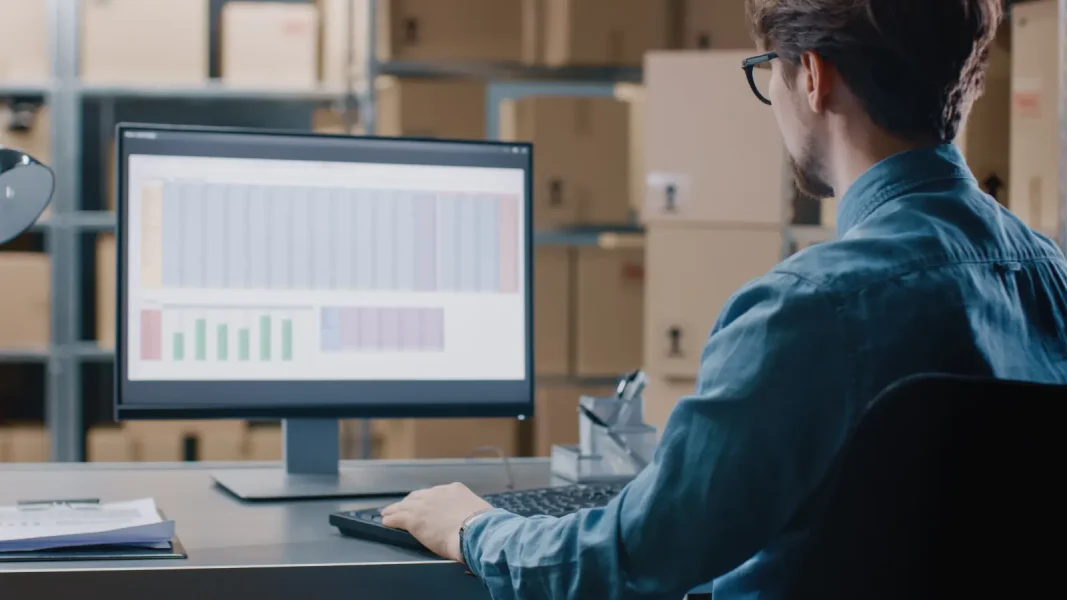Food logistics, although perceived as simple, in fact conceal a surprising complexity. According to “Logistics Bureau” research, around 33% of food products are lost or wasted during transport, underlining the considerable challenges faced by companies in the food transport sector. This statistic highlights the crucial importance of advanced technological solutions for optimizing the supply chain.
In this complex context of food retailing, where demand dynamics and market trends evolve rapidly, the implementation of forecasting software is a key factor. has become imperative. These innovations play an essential role in supply chain optimization, providing supply chain experts with powerful tools to anticipate and respond to market fluctuations.
In this article, we explore the critical role of forecasting software in food distribution, highlighting the strategic and operational advantages it offers. Find out how these tools help minimize losses, improve management of perishable products, and boost supply chain responsiveness to market challenges. Opt for an innovative solution to stay competitive in a sector where precision and operational efficiency are essential.
A Clearer View of Demand
One of the major challenges in food distribution lies in managing demand, which is often influenced by various factors such as seasons, food trends, and even world events. Forecasting software uses advanced algorithms and statistical models to analyze large data sets, providing a clearer view of demand patterns. This enables supply chain experts toanticipate fluctuations, adjust stock levels and optimize production accordingly.
Demand management remains a major concern to ensure smooth operations and customer satisfaction in the dynamic food retail sector. We’re faced with a complex landscape where variations in demand are influenced by a multitude of factors, from seasons to food trends to world events. In this context, the use of forecasting software becomes essential to obtain a clearer view of demand, enabling us to anticipate, react proactively and optimize processes.
Precise analysis with advanced algorithms
Responsiveness is an essential asset in a constantly evolving food distribution sector. Forecasting software stands out for its ability to offer exceptional responsiveness to market changes. By continuously monitoring demand data in real time, these tools enable companies to adjust quickly to changing consumer preferences.
Whether it’s to meet sudden demand, exploit new food trends, or adjust production according to the season, forecasting software is the ideal solution. become the engine that drives operational responsiveness. This ability to anticipate and react effectively to change puts companies at the head of the race, ready to capitalize on market opportunities with agility. By investing in these technologies, food retailers are positioning themselves not just to survive, but to excel in a competitive business environment.
Forecasting software uses advanced algorithms and statistical models sophisticated. These tools enable the analysis of vast data sets from a variety of sources, such as sales histories, weather data and consumer trends. This in-depth analysis enables us to understand the complex patterns of demand, identifying the factors that shape it and anticipating future fluctuations.
Sharing Forecasts with Manufacturers
The challenges of demand management in food distribution are often exacerbated by unpredictable external factors, such as natural disasters, health crises or sudden changes in consumer preferences.
By integrating these external parameters into their models, forecasting software offers the ability to react nimbly in the face of uncertainty. For example, in the event of supply chain disruption due to global events, real-time forecast adjustments can mitigate potential impacts on stock level.
Adjusting stock levels
One of the most tangible benefits of this clearer view of demand is seen in the ability to dynamically adjust inventory levels. Rather than basing decisions on rough estimates, the use of accurate, up-to-date information on forecast demand helps maintain optimal stock levels.
This avoids costs associated with unnecessary surpluses while guaranteeing the availability of the most requested products. This process enables us to better meet customer expectations and optimize financial performance.
Production Optimization for Greater Efficiency
Greater clarity on demand patterns has significant implications for the production process. By adjusting production according to precise forecasts, overproduction and the associated costs are minimized.
This optimization encompasses a holistic approach to the supply chain, boosting operational efficiency and reducing waste.
Greater responsiveness to market trends
Adapting quickly to market trends remains essential to staying competitive in the food industry. Forecasting software offers the ability to quickly detect changes in consumer preferences and emerging trends.
By adjusting our offering accordingly, we can capitalize on opportunities and stay in step with market expectations.
Inventory optimization and cost reduction
Over-management and stock-outs are persistent challenges in the demanding field of food distribution. The use of forecasting software enables precise management of stock levels by aligning supply with actual demand.
Avoiding unnecessary surpluses significantly reduces inventory management costs, while ensuring constant product availability.
Inventory optimization is not just about managing resources, it also makes a substantial contribution to minimizing the risks associated with the expiry of perishable products.
Streamlining inventory levels with accurate data
In the complex context of food distribution, where fluctuations in demand are commonplace, inventory management becomes a delicate balance between supply and demand. Forecasting software, based on accurate, up-to-date data, helps avoid the pitfalls of over-managing inventory.
The result is closer synchronization between supply and effective demand, guaranteeing judicious allocation of resources without compromising product availability.
Reducing the Costs Associated with Inventory Management
Inefficient inventory management can lead to significant costs associated with holding, tracking and managing inventories. By providing greater visibility of actual needs, forecasting software contributes to a more judicious use of resources.
This avoids the unnecessary costs associated with excessive storage and unnecessarily complex logistics processes. This proactive approach generates tangible savings throughout the supply chain.
Product Availability Guarantee
Balancing inventory management and guaranteed product availability is essential in food distribution. By accurately anticipating demand, forecasting software ensures constant availability of popular products, while avoiding stock-outs. This leads to greater customer satisfaction and strengthens the company’s reputation, while contributing to customer loyalty.
Minimizing the risk of expiration
In a sector where perishable products are ubiquitous, minimizing expiry risks is crucial. Forecasting software enables precise management of product life cycles, helping to reduce the risk of expiry.
This avoids financial losses due to stock obsolescence, while maintaining product quality for the end consumer.
Efficient Production Management
The crucial synchronization of production and demand in the food sector is greatly facilitated by the use of forecasting software. These tools enable efficient production management by providing real-time information on forecast demand.
This enables companies to fine-tune production capacity, optimize manufacturing schedules and reduce the costs associated with unnecessary overproduction.
Dynamic Adaptation of Production Capacities
The ability to react quickly to changes in demand is essential in an environment as dynamic as food distribution. Forecasting software provides an early view of trends, enabling companies to dynamically adjust their production capacities.
This real-time adaptation ensures optimum use of resources, avoiding the unnecessary costs associated with excess production capacity.
Optimizing production schedules
The precise demand management provided by forecasting software translates into optimized production schedules. In this way, production can be planned for periods of increased demand, avoiding bottlenecks and optimizing the use of production equipment.
This approach contributes directly to increased operational efficiency and reduced costs associated with inefficient planning.
Reducing the costs associated with overproduction
Unnecessary overproduction generates significant costs, particularly in terms of storage, labor and energy. By providing accurate forecasts, forecasting software enables companies to minimize these costs by aligning production with actual demand.
This close synchronization avoids production surpluses and contributes to more economical resource management.
Enhanced operational flexibility
Demand-driven production not only reduces costs, it also improves operational flexibility. Companies can quickly adjust their manufacturing processes to respond to market changes, introduce new products or adapt to emerging trends.
This operational agility enhances competitiveness in a sector where responsiveness is a major asset.
Reducing food waste
The management of perishable products, an inescapable challenge in food distribution, benefits from the contribution of forecasting software. These tools actively contribute to minimizing food waste by adjusting production and distribution in line with forecast demand.
This approach ensures optimal stock rotation, reducing the risk of food waste and promoting a more sustainable supply chain.
Anticipated management of use-by products
Les produits périssables, soumis à des contraintes de durée de vie, nécessitent une gestion proactive pour éviter les pertes inutiles. Forecasting software, by providing advance demand forecasts, enables enlightened management of best-before products.
This enables production and distribution to be fine-tuned, avoiding overproduction of products that are likely to exceed their sell-by date.
Optimal stock rotation
Stock rotation is an essential aspect of minimizing food waste. By identifying demand trends, forecasting software facilitates optimal stock rotation.
This ensures that perishable products are sold before they reach their sell-by date, reducing the risk of expiry and contributing to more efficient resource management.
Avoiding overproduction of limited-life products
Overproduction of perishable products represents a major risk of food loss. By providing real-time information on forecast demand, forecasting software helps to avoid overproduction of products with a limited lifespan.
This proactive prevention reduces the risk of overstocking, preserving product freshness while avoiding the waste associated with overproduction.
Contribution to a sustainable supply chain
Minimizing food losses has a significant impact on the sustainability of the supply chain. By encouraging more responsible management of perishable products, forecasting software contributes directly to sustainability by reducing the environmental footprint associated with food losses.
This approach, aligned with the principles of sustainable development, strengthens the position of companies in a context where environmental responsibility is playing an increasingly important role.
Informed decision-making
Strategic decision-making in the food supply chain requires an in-depth understanding of market trends. By providing advanced analytical data, forecasting software lays a solid foundation for informed decision-making by supply chain experts.
Whether for new product launches, promotional planning or geographic expansion, these technological tools ensure the availability of valuable information, guiding strategic choices.
In-depth analysis of market trends
In-depth analysis of market trends is essential to anticipate new developments and keep pace with consumer expectations. Using advanced algorithms, forecasting software enables in-depth analysis of food market trends.
These analyses offer invaluable insight into buying behavior, consumer preferences, and emerging opportunities, providing a solid basis for informed strategic decisions.
Precise Information for New Product Launches
Launching new products in the food sector requires a detailed understanding of market demands. Forecasting software provides precise information on anticipated demand, enabling us to assess the viability and potential success of new products.
This precision in anticipating demand facilitates the launch process by minimizing the risks associated with an unsuitable offer or an underestimation of demand.
Strategic Promotion Planning
Planning promotions requires a detailed understanding of demand cycles and buying behavior. By providing detailed analyses, forecasting software enables strategic planning of promotions.
This approach allows us to optimize the timing of promotions, adjust stock levels accordingly, and increase the overall effectiveness of promotional initiatives.
Precise Orientation for Geographic Expansion
Geographical expansion in food distribution requires careful assessment of the opportunities and challenges specific to each market. Forecasting software provides region-specific information to guide geographic expansion decisions.
Whether it’s adapting offers to local preferences or managing stock levels according to variations in regional demand, these tools contribute to more strategic expansion.
Integrated Supply Chain Collaboration
An efficient supply chain relies on collaboration between the various players. Forecasting software facilitates this collaboration by enabling the transparent sharing of information between suppliers, manufacturers, distributors and retailers.
This integrated communication promotes more precise planning, greater responsiveness to market changes, and overall optimization of the food supply chain.
Transparent information sharing between stakeholders
Effective supply chain collaboration starts with transparent information sharing. By centralizing data and forecasts, forecasting software facilitates this sharing between the various links in the chain.
Suppliers can adjust their production according to demand forecasts, manufacturers can adapt their manufacturing schedules, and distributors can optimize their stock levels accordingly.
Precise planning through integrated communication
Integrated communication, made possible by forecasting software, promotes more accurate planning at all levels of the supply chain. Actors can base their decisions on up-to-date, shared information, thus avoiding discrepancies or inefficiencies linked to fragmented information.
Collaborative planning makes it possible to anticipate fluctuations in demand, optimize stock levels and adjust production to actual market needs.
Greater responsiveness to market changes
In a dynamic business environment, responsiveness to market changes is essential. By providing real-time information on demand and market trends, forecasting software enables us to react more quickly.
Necessary adjustments can be made quickly, whether to meet unforeseen demand or to cope with sudden changes in consumer preferences.
Global Optimization of the Food Supply Chain
By fostering collaboration and integrated communication, forecasting software contributes to global optimization of the food supply chain. Inefficiencies and costs associated with fragmented processes are minimized, and resources can be allocated more wisely.
This holistic approach strengthens the operational coherence of the supply chain, creating a more efficient and responsive ecosystem.
----------------------------
The adoption of forecasting software in food distribution is a strategic imperative. These tools offer major advantages such as real-time data provision, anticipation of market trends, and supply chain optimization.
They have become indispensable for remaining competitive in a dynamic business environment. The increased clarity of demand enabled by this software is an invaluable asset, promoting agile, future-oriented supply chain management.
Whether for production management, food waste reduction, strategic decision-making or customer satisfaction, these technologies have become essential strategic partners. Investment in these technological solutions is no longer simply a benefit, but a necessity if we are to thrive in today’s complex and demanding food sector.
The advanced analytical data provided by our Optimix XFR supply chain solution guides strategic decision-making, while integrated supply chain collaboration promotes accurate planning.
By improving customer satisfaction through consistent product availability, APS positions retailers for sustainable growth, cost reduction and operational excellence in a competitive environment.
Please contact us or request a demo to find out more about the strategic and operational benefits of integrating our APS solution into your business.








